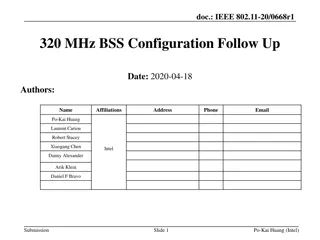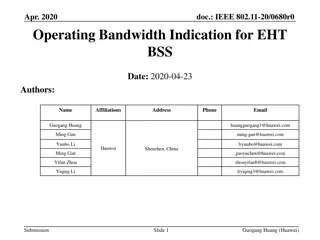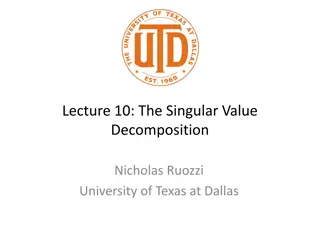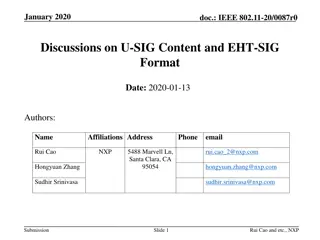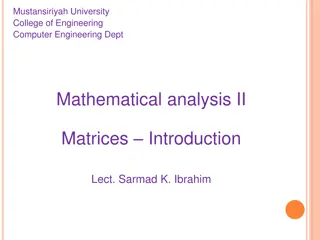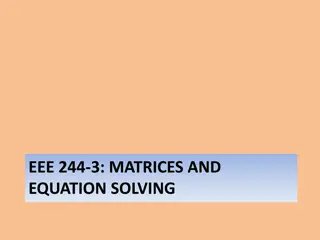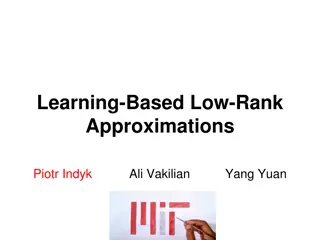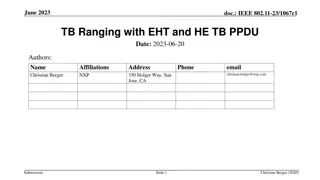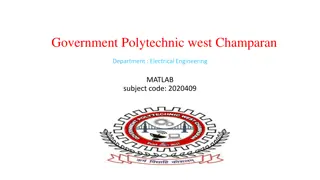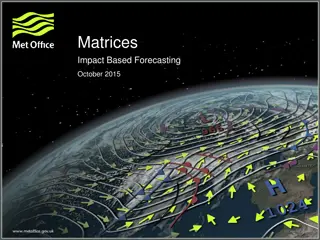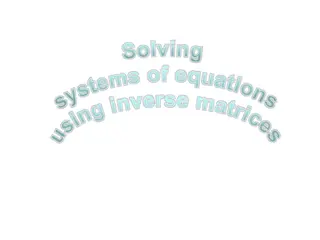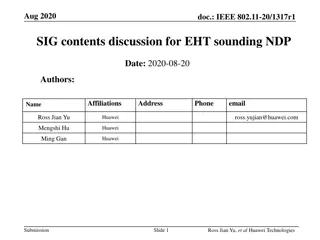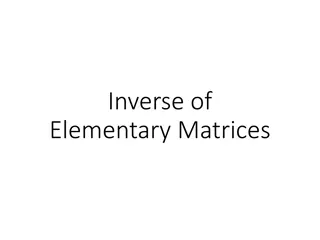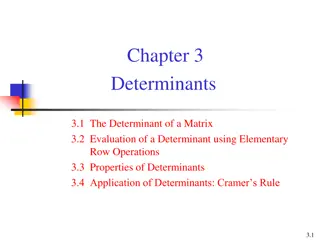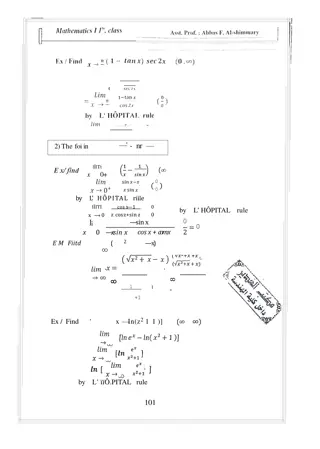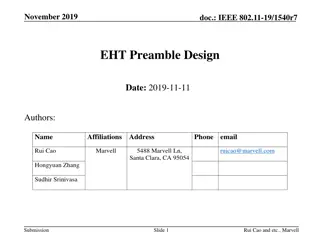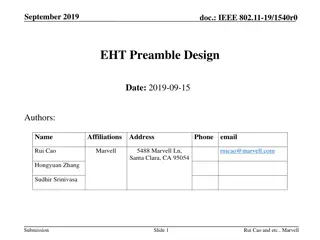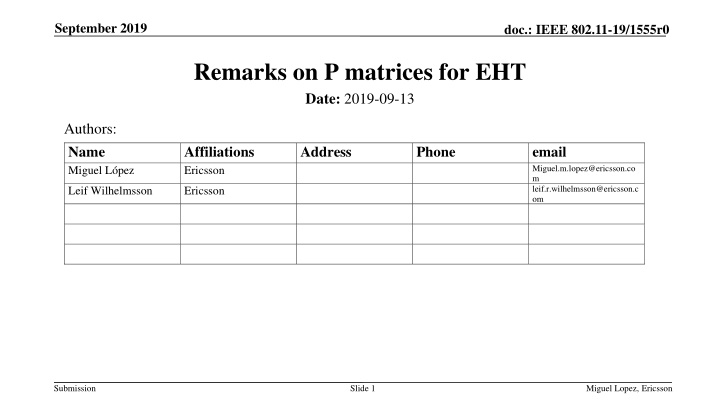
Discussing P Matrices for EHT in IEEE 802.11-19/1555r0 Document
This contribution explores the requirements, design options, and examples of P matrices for Enhanced High Throughput (EHT) in IEEE 802.11-19/1555r0. It covers the importance of P matrices for MIMO channel estimation, dimensions needed for EHT matrices, and the orthogonality aspect in EHT matrices to support high-order MIMO. Suggestions are made for standardizing matrices to streamline implementation and support fast matrix-vector multiplication algorithms.
Download Presentation

Please find below an Image/Link to download the presentation.
The content on the website is provided AS IS for your information and personal use only. It may not be sold, licensed, or shared on other websites without obtaining consent from the author. If you encounter any issues during the download, it is possible that the publisher has removed the file from their server.
You are allowed to download the files provided on this website for personal or commercial use, subject to the condition that they are used lawfully. All files are the property of their respective owners.
The content on the website is provided AS IS for your information and personal use only. It may not be sold, licensed, or shared on other websites without obtaining consent from the author.
E N D
Presentation Transcript
September 2019 doc.: IEEE 802.11-19/1555r0 Remarks on P matrices for EHT Date: 2019-09-13 Authors: Name Miguel L pez Affiliations Ericsson Address Phone email Miguel.m.lopez@ericsson.co m leif.r.wilhelmsson@ericsson.c om Leif Wilhelmsson Ericsson Submission Slide 1 Miguel Lopez, Ericsson
September 2019 doc.: IEEE 802.11-19/1555r0 Abstract This contribution discusses requirements for the P matrices, gives an overview possible matrix designs and presents examples of P matrices Submission Slide 2 Miguel Lopez, Ericsson
September 2019 doc.: IEEE 802.11-19/1555r0 ? matrices (recap) The ? matrices enable MIMO channel estimation at the receiver. The channel matrix ?? corresponding to subcarrier ? may be estimated as follows: ? ?? ???? ???? Where ? is the P matrix, ? = [??,?, ,??,????] is a matrix of dimension ??? ???? that collects the received signal vectors ??,?corresponding to the ?-th subcarrier and ?-th LTF symbol ??= Computations of the form ??? ?????? ??, or equivalently ? ?????? ?????? are required 802.11 has standardized matrices ??,??,??,??= ?? ?? of order 2, 4, 6, 8 Slide 3 Submission Miguel Lopez, Ericsson
September 2019 doc.: IEEE 802.11-19/1555r0 ? matrices in EHT (1) EHT will support up to 16 SS In order to limit the preamble bloating due to unnecessary overhead, it is suggested to at least standardize ? matrices of dimensions 10, 12, 14 and 16. new ? matrices are needed The HE ? matrices are orthogonal Orthogonality is necessary to support high order MIMO EHT ? matrices should be orthogonal Submission Slide 4 Miguel Lopez, Ericsson
September 2019 doc.: IEEE 802.11-19/1555r0 ? matrices in EHT (2) EHT will likely support channel BW of 320 MHz, 16 SS and multi-link. With multi-link aggregation, bandwidths exceeding 1 GHz are being proposed [1] up to 16 1 ??? 78125 ?? 2 105matrix-vector multiplications may be needed for channel estimation. (The same number of multiplications are required for each midamble.) In VHT/HE, a receiving STA can identify interfering spatial streams intended for other STAs and employ Interference Cancellation (IC) EHT should support IC With IC, STAs need to estimate MIMO channel for all SS ? matrix-vector multiplication algorithms are required even for STAs that have few antennas (e.g. 2 or 4 antennas) Example: 16x16 MU-MIMO, one SS per STA, each STA with 2 RX each STA needs to perform two matrix-vector multiplications It is suggested to standardize ? matrices that support the implementation of fast matrix-vector multiplication algorithms. Slide 5 Submission Miguel Lopez, Ericsson
September 2019 doc.: IEEE 802.11-19/1555r0 ? matrices in EHT (3) A STA may not need to compute the product of the full ? matrix with vectors of received samples If ???= ??? then the STA may have a simple receiver that does not employ IC no need to identify of interfering streams/IC. An important example are STAs with only one RX antenna Channel estimation requires only to multiply vectors of received samples by some selected rows of the ? matrix (e.g. ?????? ?????? in the case of 1 RX antenna) The ? matrix should support efficient implementation of row-of-matrix vector to better support low end STAs (e.g. single RX antenna STAs) Submission Slide 6 Miguel Lopez, Ericsson
September 2019 doc.: IEEE 802.11-19/1555r0 Overview of Some Orthogonal Matrices The DFT matrices exist for all orders. Multiplication by DFT matrices of order 16 can be efficiently implemented and optimized for all types of HW Orthogonal ? matrices exist for orders 12 and 16, but do not exist for orders 9, 10, 11, 13, 14 and 15 ? matrices are convenient for digital implementation since matrix multiplication requires only additions, and are particularly well suited for ASIC/FPGA/fixed point DSP implementations. Orthogonal ?, ? matrices exist for orders 10 and 14 but do not exist for orders 9, 11, 13 and 15 These matrices are convenient for digital implementation since multiplication by ? requires only sign changes and swapping of real and imaginary parts, and are particularly well suited for ASIC/FPGA/fixed point DSP implementations. Submission Slide 7 Miguel Lopez, Ericsson
September 2019 doc.: IEEE 802.11-19/1555r0 ? Matrices of order 16 It is rather straightforward to generate orthogonal ? matrices of order 16 by taking Kronecker products (denoted ) of orthogonal matrices of smaller orders. Consider the following examples (recall that ??, ??, ?? are the 802.11 ? matrices of orders 2, 4 and 8 respectively) ?? ?? ?? ??(textbook example of Hadamard matrix) ?? ?? ?? ??= ?? ?? ?? Minor modifications, such as negation of columns, preserve orthogonality and may be desirable in some cases (e.g. for the textbook Hadamard) All of the above examples are highly structured and support fast multiplication Slide 8 Submission Miguel Lopez, Ericsson
September 2019 doc.: IEEE 802.11-19/1555r0 ? Matrices of order 12 Consider the matrix 1 -1 -1 1 -1 1 -1 -1 1 1 1 1 1 1 -1 -1 1 1 -1 1 -1 1 1 -1 1 1 1 1 1 -1 -1 -1 -1 -1 1 1 -1 1 1 -1 -1 1 -1 1 1 -1 1 1 1 1 1 -1 -1 1 1 -1 -1 1 -1 1 1 -1 1 -1 1 -1 1 1 1 1 1 1 1 1 -1 1 1 1 1 1 1 -1 -1 1 1 1 1 1 -1 -1 -1 1 1 1 -1 -1 1 -1 1 1 -1 1 1 1 -1 -1 1 -1 -1 1 1 1 1 1 1 -1 1 1 1 -1 -1 -1 1 1 1 1 -1 1 -1 1 -1 1 -1 1 -1 1 -1 -1 1 1 -1 1 1 1 ???= All orthogonal ? matrices of order 12 can be derived from this matrix by swapping rows or columns, and negating rows or columns Submission Slide 9 Miguel Lopez, Ericsson
September 2019 doc.: IEEE 802.11-19/1555r0 ?, ? Matrices of order 14 Consider the matrix -j 1 1 1 1 1 -1 1 -1 1 1 -1 1 -1 1 -j -1 1 -1 -1 -1 1 -1 1 -1 1 1 1 1 -1 -j -1 1 -1 1 1 -1 1 1 1 -1 -1 1 1 -1 -j -1 1 1 -1 -1 1 1 -1 -1 1 1 -1 1 -1 -j -1 -1 -1 1 1 1 -1 1 1 1 -1 -1 1 -1 -j 1 1 1 -1 1 -1 1 -1 -1 -1 1 1 -1 1 -j 1 1 1 1 1 -1 1 1 1 1 -1 -1 1 1 -j 1 1 -1 1 1 -1 -1 -1 -1 -1 1 1 1 1 -j 1 -1 -1 1 1 1 1 1 1 1 -1 1 1 1 -j -1 -1 -1 1 1 -1 1 1 1 1 1 -1 -1 -1 -j 1 1 1 -1 1 1 -1 -1 -1 1 1 -1 -1 1 -j 1 1 1 1 -1 -1 1 1 -1 1 1 -1 1 1 -j 1 -1 1 -1 1 1 -1 1 -1 1 1 1 1 1 -j ???= ??? is an orthogonal matrix with 14 purely imaginary elements along the diagonal, while the remaining 182 elements are ? s Submission Slide 10 Miguel Lopez, Ericsson
September 2019 doc.: IEEE 802.11-19/1555r0 ?, ? Matrices of order 10 Consider the matrix -j 1 -1 1 1 1 -1 -1 1 1 1 -j -1 1 1 1 1 1 -1 -1 -1 -1 -j 1 1 -1 1 1 1 1 1 1 1 -j 1 -1 -1 1 1 -1 1 1 1 1 -j -1 1 -1 -1 1 1 1 -1 -1 -1 -j 1 1 1 1 -1 1 1 -1 1 1 -j 1 -1 1 -1 1 1 1 -1 1 1 -j 1 -1 1 -1 1 1 -1 1 -1 1 -j 1 1 -1 1 -1 1 1 1 -1 1 -j ???= ??? is an orthogonal matrix with 10 imaginary elements along the diagonal, while the remaining 90 elements are ? s Submission Slide 11 Miguel Lopez, Ericsson
September 2019 doc.: IEEE 802.11-19/1555r0 Summary It has been pointed out that it is desirable to have P matrices that support efficient implementations of fast channel estimation algorithms P matrices should support efficient matrix by vector and matrix-row byvector computations There is no penalty associated with choosing the P matrices that support fast multiplication algorithms. Examples of orthogonal ? - matrices and ?, ? -matrices of orders 10, 12, 14 and 16 have been given Submission Slide 12 Miguel Lopez, Ericsson
September 2019 doc.: IEEE 802.11-19/1555r0 Straw poll #1 Regarding the standardization of P matrices in EHT, which option do you prefer? Opt 1) Standardize P matrices of orders 9, 10, 11, 12, 13, 14, 15 and 16 Opt 2) Standardize only P matrices of orders 10, 12, 14, and 16 Opt 3) Standardize only P matrices of orders 12 and 16 Opt 4) Standardize only one P matrix of order 16 Opt 5) None of the above Opt1/opt2/opt3/opt4/opt5 Submission Slide 13 Miguel Lopez, Ericsson
September 2019 doc.: IEEE 802.11-19/1555r0 Straw poll #2 Do you agree that the EHT P matrices of order larger than 8 should support the implementation of efficient algorithms for the multiplication of a P matrix by a vector, as well as efficient algorithms for the multiplication of a P matrix row by avector? Y/N/A Submission Slide 14 Miguel Lopez, Ericsson
September 2019 doc.: IEEE 802.11-19/1555r0 References [1] R. Jian Yu, 11be Peak Data Rate Analysis , IEEE 802.11-19-0754-00- 00be, May 2019 Submission Slide 15 Miguel Lopez, Ericsson

